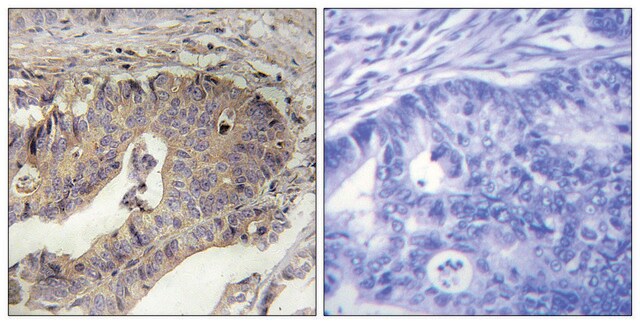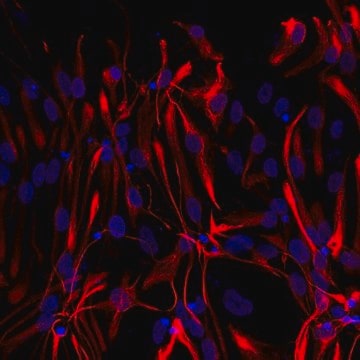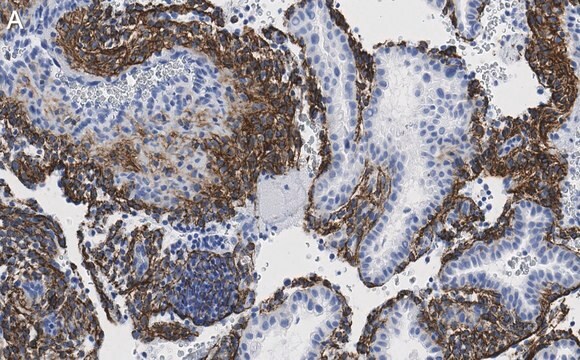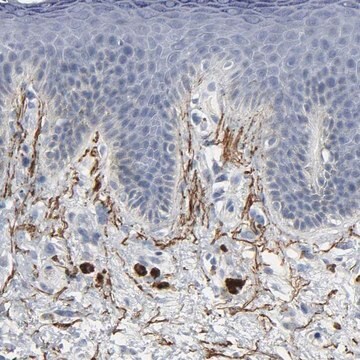MAB1919
Anti-Fibrillin Antibody, clone 11C1.3
clone 11C1.3, Chemicon®, from mouse
Synonym(e):
Anti-ACMICD, Anti-FBN, Anti-GPHYSD2, Anti-MASS, Anti-MFLS, Anti-MFS1, Anti-OCTD, Anti-SGS, Anti-SSKS, Anti-WMS, Anti-WMS2
About This Item
Empfohlene Produkte
Biologische Quelle
mouse
Qualitätsniveau
Antikörperform
purified antibody
Antikörper-Produkttyp
primary antibodies
Klon
11C1.3, monoclonal
Speziesreaktivität
bovine, pig, human
Hersteller/Markenname
Chemicon®
Methode(n)
ELISA: suitable
immunofluorescence: suitable
immunohistochemistry: suitable (paraffin)
immunoprecipitation (IP): suitable
western blot: suitable
Isotyp
IgG1κ
NCBI-Hinterlegungsnummer
UniProt-Hinterlegungsnummer
Versandbedingung
dry ice
Posttranslationale Modifikation Target
unmodified
Angaben zum Gen
human ... FBN1(2200)
Spezifität
Immunogen
Anwendung
Zellstruktur
ECM-Proteine
Immunohistochemistry: fresh frozen tissue: 1:200-1:500. Paraffin sections reactive after microwave citrate buffer antigen retrieval.
Immunoprecipitation: 5 microliters of antibody diluted in no more than 400 microliters of concentrated supernatants from bovine smooth muscle cells. We recommend either an anti-mouse IgG bead or a rabbit anti-mouse capture antibody followed by protein A.
ELISA
Optimal dilutions must be determined by the end user.
Physikalische Form
Lagerung und Haltbarkeit
Rechtliche Hinweise
Haftungsausschluss
Sie haben nicht das passende Produkt gefunden?
Probieren Sie unser Produkt-Auswahlhilfe. aus.
Empfehlung
Lagerklassenschlüssel
12 - Non Combustible Liquids
WGK
nwg
Flammpunkt (°F)
Not applicable
Flammpunkt (°C)
Not applicable
Analysenzertifikate (COA)
Suchen Sie nach Analysenzertifikate (COA), indem Sie die Lot-/Chargennummer des Produkts eingeben. Lot- und Chargennummern sind auf dem Produktetikett hinter den Wörtern ‘Lot’ oder ‘Batch’ (Lot oder Charge) zu finden.
Besitzen Sie dieses Produkt bereits?
In der Dokumentenbibliothek finden Sie die Dokumentation zu den Produkten, die Sie kürzlich erworben haben.
Unser Team von Wissenschaftlern verfügt über Erfahrung in allen Forschungsbereichen einschließlich Life Science, Materialwissenschaften, chemischer Synthese, Chromatographie, Analytik und vielen mehr..
Setzen Sie sich mit dem technischen Dienst in Verbindung.








